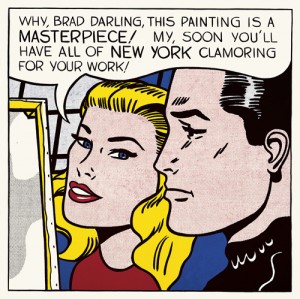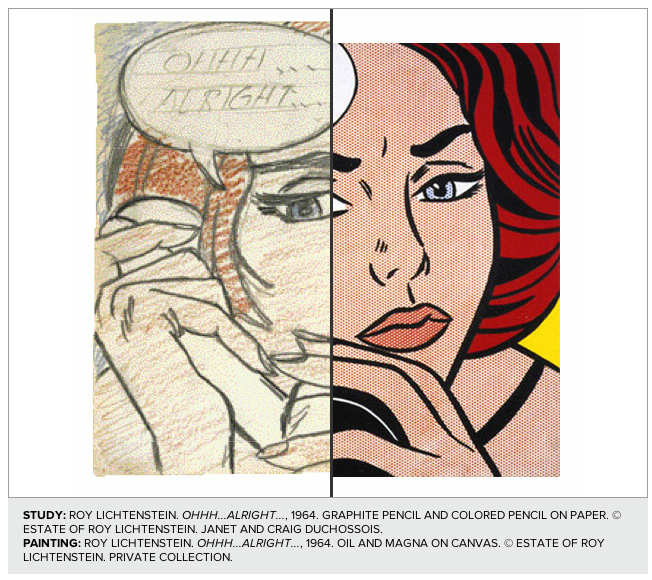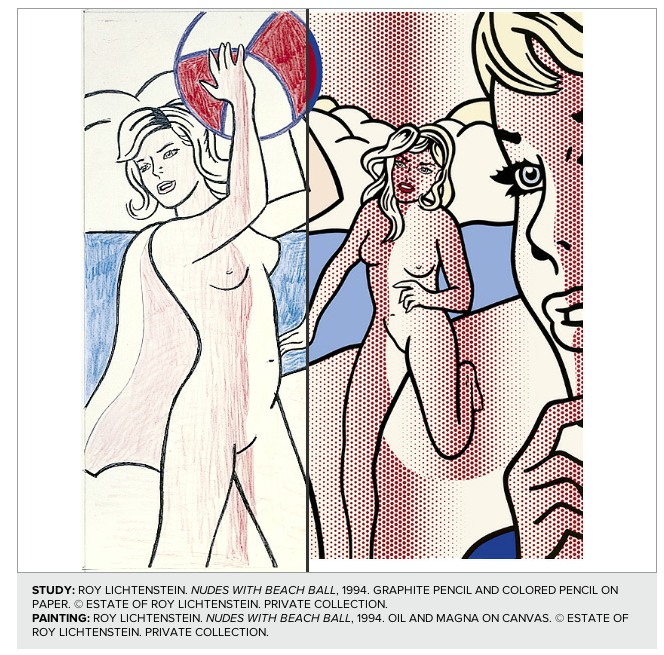While the NATO protesters danced in the rain outside the Art Institute of Chicago, inside rests a magnificent collection from the one and only Roy Lichtenstein. The image featuring droves of rows of cops in full-on riot gear standing in solidarity at the facade of the Art Institute with the triple paneled Lich-Ten-Stein in the upper background will become historical in its own sense. And there’s Ole Roy just hanging out at the top of the image. I’m sure he’s more than thrilled to be here in Chicago during NATO, parodying the whole scenario. Hell, he may have even planned it himself, the eternal satirist he is!

Parody has and always will be a part of art, especially Pop Art, so when Pop Art critics dare to take away credibility of not only Lichtenstein but all Pop Artists, they are doing so in vain. When naysayers use the phrase “stealing images,” the redundancy is ridiculous, and clear-cut ignorance to an entire movement is taking place. Using images and reinterpreting them and creating a social commentary is exactly what Pop Art is! It is to be understood that fine art aficianados are challenged to accept the principles that come along with the Pop Art movement, because the ironic use of comic strips, advertisements, cartoons, the news, and other pop culture phenomena are supposed to reserved for the commonplace, not the elite.
Little did they know how blurred the lines would become…
Our Art Institute of Chicago has once again put together a collection of which the art gods can be very proud, starting with Lichtenstein’s Early Pop series from 1961-62.
The raw and seemingly (at first) innocent nature of 1961’s Look Mickey has blazed the trail for endless Disney parodies, and the tone set throughout the Early Pop Era is one that has become both symbolically iconic and ironically elegant. Notable pieces in this era’s collection include The Ring (Engagement), 1962, Keds, 1961, and Spray, 1962.
Lichtenstein’s War and Romance Era from 1961-66 includes Drowning Girl, 1963, Whaam!, 1963, Masterpiece, 1962, and We Rose Up Slowly, 1964, whose side panel reads the poetically poignant quote:
“We rose up slowly…as if we didn’t belong to the outside world any longer…like swimmers in a shadowy dream…who didn’t need to breathe…”
Lichtenstein’s Black and Whites from 1961-66 feature Portable Radio, 1962, Compositions I, 1964, The Ring, 1962, and Desk Calendar, 1962.
Brushstrokes (1965-71) and Explosions (1963-68) has on display Brushstrokes, 1965, which was Lichtenstein’s sly homage to Abstract Expressionism, and Varoom!, 1963.
Lichtenstein’s Landscapes collection from 1964-71 are appealingly separate from avant-garde concerns, featuring the likes of Sunrise, 1965, treating the viewer to Pop-classic blue and red dots and bold, exploding yellow sun rays emitting sunshine for the day ahead. The fierce red sun and white puffy clouds create a landscape with which many of us should reconnect and instantly can through this work of art.
As we enter the Art History wing from 1951-90, we are graciously greeted with a sprawling layout of appropriation, repetition, stylization, and parody including the massive, unmistakable Laocoon, 1988 at the end of the long gallery. Lichtenstein: “The things that I have apparently parodied, I actually admire.” Also in this set: Rouen Cathedral, Set 5, 1969 with its trifecta of magic eyeish (remember those?) replication, Nonobjective I, 1964 in all its seminal pop art glory on the wall as a forever iconic image of pop art, and Reflections of Interior with Girl Drawing, 1990 practically splicing two works into one.
The Modern series, 1966-71, has Lichtenstein humorously stylizing an already-stylized style with comically titled pieces such as Modern Painting I, 1966, Modern Painting with Division, 1967, Modern Painting with Bolt, 1967, and Modern Painting with Triptych, 1967.
Moving into The Mirrors series, 1969-72, showcased a finer side to Lichtenstein’s art.
Difficult to merely render, the representation of a reflecting mirror has long been a sign of technical virtuosity, and Lichtenstein’s interpretations including Mirror #3 (Six Panels), 1971 are no exception.
Entire rooms dedicated to Perfect/Imperfect, 1978-95 and Nudes, 1994-97 separate this collection from ordinary collections, not to mention the hallway filled with Works on Paper. “”It’s all thought up in the drawings and all accomplished in the paintings.”

The viewer exits this exhibit appropriately and chronologically through Landscapes,
1996-97. Inspired by classical motifs by the Song Dynasty (960-1279), Lichtenstein’s evolution and repertoire expansion is fulfilled with works like Landscape with Philosopher, 1996, Treetops Through the Fog, 1996, and Yellow Cliffs, 1996.
Sculpture: Head With Blue Shadow, 1965; Archaic Head, VI, 1988;
Modern Sculpture with Velvet Rope, 1968; Imperfect Sculpture, 1995; Scholar’s Rock, 1996-97

In this retrospective, Lichtenstein’s best known, large-scale appropriations of distressed young women and daring young men featured in war and romance comics are on full display. The viewer is given an exciting opportunity to travel through each era of the artist’s prolific career. Roy Lichtenstein is and always will be a Pop icon and one of the two most importantly prolific American Pop Artists ever to convey thought in their own unique way. His work has become synonymous with American Pop Art and the movement it encompasses. He brought the commonplace to the realm of fine art. His perfectly placed dots, essential for comic style, are just the tip of the iceberg of his artistic brilliance. Naysayers have criticized not only Lichtenstein but all pop artists for “stealing images.” Well, guess what? That’s what pop art is.
“No idea is original, there’s nothing new under the sun, it’s never what you do, but how it’s done.”
-Nasir Jones, The Lost Tapes